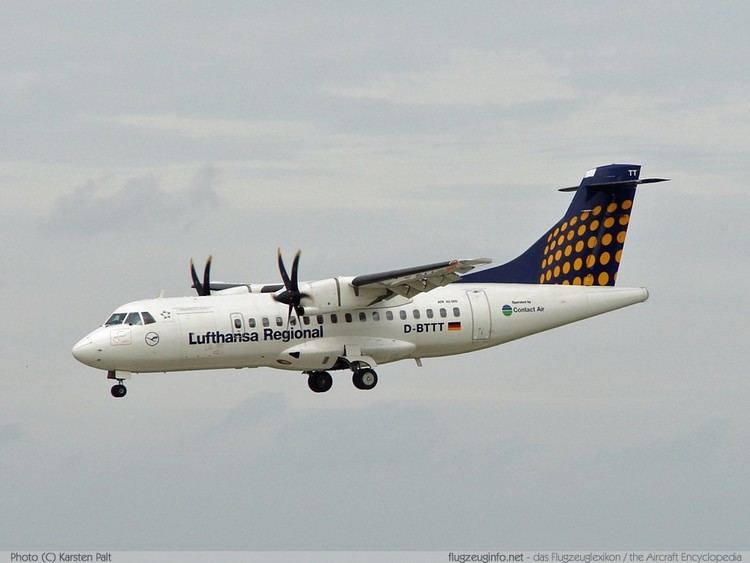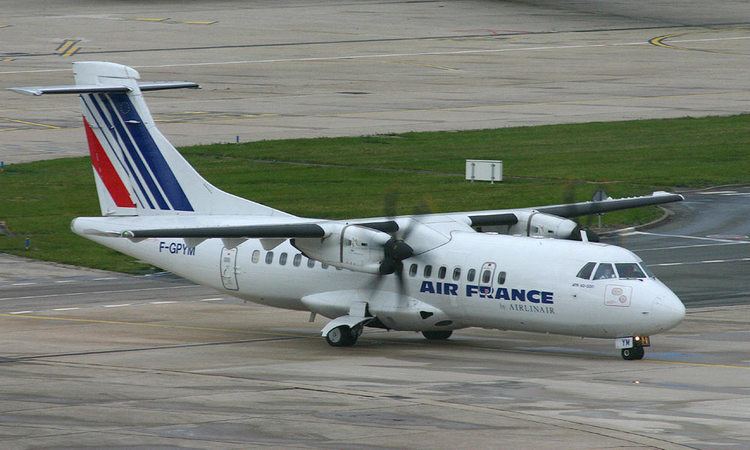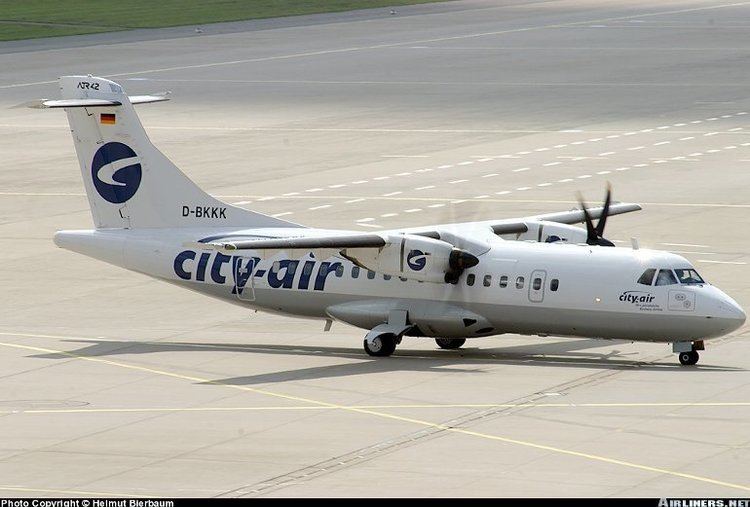Wingspan 25 m Introduced 3 December 1985 | Length 23 m Engine type Turboprop First flight August 16, 1984 | |
 | ||
Unit cost 12,000,000–16,000,000 USD (2008) | ||
Air india regional atr 42 320 taxiing at delhi igi airport terminal 1d india
The ATR 42 is a twin-turboprop, short-haul regional airliner built in France and Italy by ATR (Aerei da Trasporto Regionale or Avions de transport régional). ATR models have their final assembly in Toulouse, and share resources and technology with Airbus. The name "42" comes from the aircraft's standard seating, which varies from 40 to 52. The aircraft serves as the basis for the larger ATR 72.
Contents
- Air india regional atr 42 320 taxiing at delhi igi airport terminal 1d india
- Atr 42 72 tribute
- Design and development
- ATR 42200
- ATR 42300
- ATR 42320
- ATR 42400
- ATR 42500
- ATR 42600
- Other versions
- Civil operators
- Military and government operators
- Accidents and incidents
- References

Atr 42 72 tribute
Design and development

The ATR 42–300 was announced in 1981, making its maiden flight on 16 August 1984; French and Italian certification followed in September 1985 and its first revenue flight was in December with Air Littoral of France. This initial version of the ATR 42 was in production until 1996. The next upgrade for the product was the ATR 42-320 (also produced until 1996); this variant differed in that it was equipped with the more-powerful PW-121 engines for improved performance. The ATR 42-300QC is a quick-change (convertible) freight/passenger version of the standard −300 series.

The next production version is the −500 series. It was an upgraded aircraft with new PW127 engines, new six blade propellers, improved hot and high performance, increased weight capacity and an improved passenger cabin. The 50-seat ATR 42–500 was first certificated in July 1995. The current production version is the -600 series. Announced in 2007 with deliveries starting in 2012, it is similar to the -500 but features PW127M engines, a new glass cockpit, and a variety of other minor improvements. As of December 2014, 436 ATR 42 aircraft had been delivered worldwide.
ATR 42–200

The −200 was the original ATR 42 prototype and only a few were built for testing purposes. It was powered by Pratt & Whitney Canada PW120 engines rated at 1,800 shp (1,300 kW).
ATR 42–300

The −300 was the standard production version. This model was manufactured until 1996. It was powered by Pratt & Whitney Canada PW120 engines rated at 2,000 shp (1,500 kW).
ATR 42–320

The −320 was an improved version of the −300 powered by PW121 engines (2100 shp). It was designed to have better performance especially in hot and high conditions.
ATR 42–400
The ATR 42−400 is an upgraded version of the −320 using six-bladed propellers on otherwise identical PW121 engines. Three ATR 42−400 were delivered to the Government of Italy as the ATR 42 "Surveyor" version. The only two civilian ATR 42-400 produced (msn 487 & 491) were delivered to CSA Czech Airlines in 1995/1996 as an interim upgrade prior to delivery of -500s. In 2006 these two aircraft were sold to Conviasa.
ATR 42–500
The ATR 42-500 is the current production version with the first delivery in October 1995. It has many improvements for performance and passenger comfort including new engines, new propellers, a newly designed cabin, and increased weight. It has six-bladed propellers powered by PW127E engines rated at 2,400 shp (1,800 kW) for improved hot and high performance and increased cruise speed. The engines are flat rated for +45C. Propellers are electrically controlled and are made from composite. It has an increased maximum takeoff weight, allowing for more cargo and greater range. Due to the six-bladed propellers and better insulation, it has reduced noise levels. The newest version have CATII capability and dual Honeywell HT1000 FMS installation.
ATR 42–600
On 2 October 2007, ATR CEO Stéphane Mayer announced the launch of the −600 series aircraft. The ATR 42–600 and ATR 72–600 featured various improvements to increase efficiency, dispatch reliability, lower fuel burn and operating costs. The PW127M is the standard engine (providing 5% additional thrust, thus improving performance on short runways, in hot weather and on high altitude; the "boost function" activates this additional power as needed), a Glass Cockpit flight deck featuring five wide LCD screens replaced the previous EFIS (Electronic Flight Instrument System). In addition, a Multi-Purpose Computer (MPC) enhances flight safety and operational capabilities. Avionics supplied by Thales provides CAT III and RNP capabilities. It also includes lighter, more comfortable seats and larger overhead baggage bins.
Using the test registration F-WWLY, the prototype ATR 42–600 first flew on 4 March 2010. The first aircraft was delivered to Tanzanian airline Precision Air in November 2012. According to the ATR42 & 72 EASA Type Certificate Data Sheet TCDS A.084, Iss 3, 17-10-2012 ), "ATR 42-600" is the manufacturer's marketing designation of ATR 42-500 aircraft model with the NAS (New Avionic Suite, or 'Glass Cockpit') modification installed. The "ATR 42-600" marketing designation is not recognised by EASA as any new certified aircraft model or variant, and must not be used on ATR certified/approved documentation, where only "Mod 5948", "ATR 42-500 with Mod 5948", "ATR 42-500 fitted with NAS", or ATR 42-500 "600 version" must be indicated.
Other versions
Bulk (tube versions) and ULD freighter (large cargo door). An STC exists to convert all ATR-42 variants to all-cargo transport aircraft. FedEx, Aviavilsa, UPS, and DHL are major operators of the type.
The ATR-42 "Surveyor" is a maritime patrol version of the −400,
VIP transport and in-flight inspection versions of the −500 also exist.
Civil operators
Included in this list are civil operators with 10 airframes or more on 19 January, 2017.
Military and government operators
Accidents and incidents
There have been a total of 32 hull losses of ATR 42s, as of December 2016.
